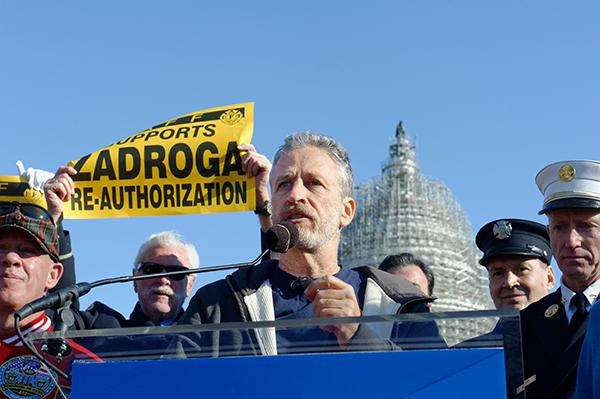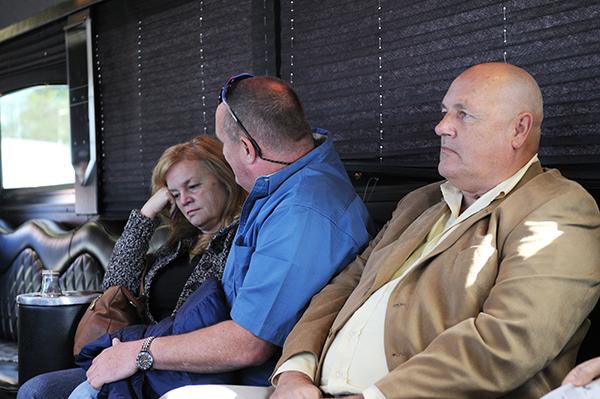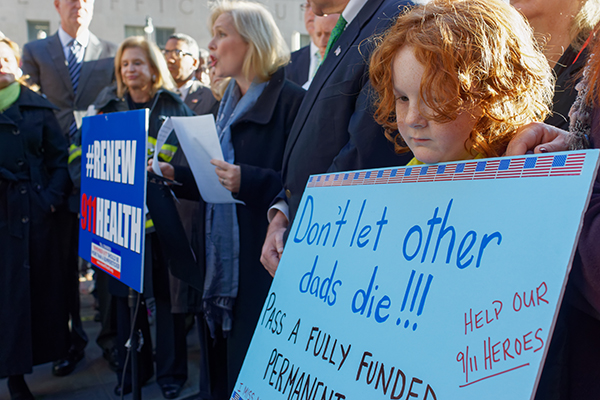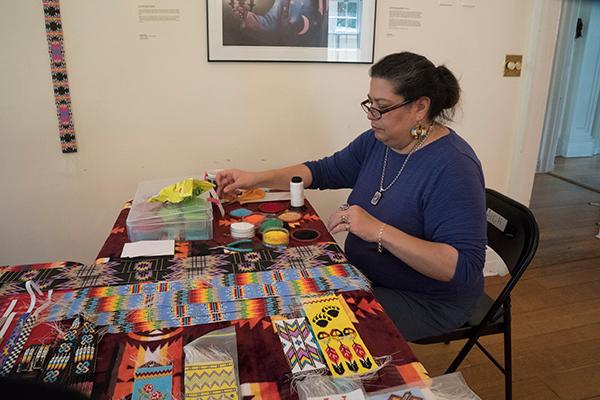|
DOWNTOWN
POST NYC
News and Events
in Lower Manhattan
|
|
|
|
Volume 6,
No.
12 July 25, 2019
|
QUOTE OF THE DAY:
"Let us now be with our loved ones and enjoy whatever quality of life we may have."
- John Feal, a retired construction worker who was gravely injured at the World Trade Center site. He founded the FealGood Foundation, which for years lobbied members of the U.S. Congress to provide additional funding for 9/11 responders.
|
On the morning of Sept. 29 nine years ago, I was standing outside the building occupied by the DC37 union at Barclay and West Streets. A lot of people were waiting with me. Before long, a bus pulled up and we boarded it. Ahead of us that day was more than nine hours of travel, to Washington, D.C. and back.
We were going to Washington to lend our support to the James Zadroga 9/11 Health and Compensation Act, up for its second vote in the House of Representatives. If passed, the bill would be the first step in providing ongoing health care for uniformed workers and volunteers at Ground Zero and would also address the health needs of neighborhood residents. Of equal importance, it would reopen the federal Victim Compensation Fund so that people who could no longer work and the families of those who had died would have some income.
In New Jersey, the bus pulled into a rest stop and some more people got on. Among them was Joseph Zadroga, whose son, Jimmy, an NYPD detective, died in 2006 at the age of 34 because of exposure to World Trade Center toxins. After Jimmy's death, Mr. Zadroga said that he and his wife had decided to become advocates for people who were sick because they had worked at the World Trade Center or lived nearby.
The mood on the bus was solemn. Everyone knew that the vote in the House could go either way. Some people on the bus tried to get some sleep. No one said much. The tension mounted.
As it turned out, later that day at 3:32 p.m., the vote to pass the bill went over the top in the House. The final vote was 268 to 160, with 255 Democrats and 13 Republicans supporting the bill. There was applause on the House floor and the people who had come down on the bus were on their feet in the gallery, cheering and applauding. Representative Carolyn Maloney, one of the chief backers of the bill, stood near the Speaker's desk in her pearls and dark pink suit, pumping her fist in the air.
But on the ride back to New York, joy was tempered by the knowledge that the bill still had to pass the Senate.
On Nov. 16, 2010, I made the trip to Washington again. After the Thanksgiving recess, the bill would come up for a vote in the Senate. Sixty votes were needed to prevent a filibuster that would kill the bill, probably forever. It had 58 supporters.
On the bus that day were first responders, Lower Manhattan residents, members of 9/11 families and City Councilmember Margaret Chin. Several people on the bus said that although they were sick themselves, they were there to speak for those who were too sick to make the trip or who had already died from 9/11-related illnesses.
It was raining hard when the bus reached Washington, nearly five hours after leaving New York. The group split up into teams so that they could visit every Senatorial office, speaking to someone as highly placed as possible and leaving literature about what was at stake.
The group trudged from office to office for hours. Sometimes they were only able to speak to receptionists. Sometimes a legislative aide invited them to sit down and make their case.
At 2:30 p.m. the group stopped its lobbying to attend a press conference where Sen. Kirsten Gillibrand, sponsor of the bill in the Senate, Sen. Charles Schumer and other politicians and union representatives spoke.
"Nine years ago, no one could have imagined that our nation would ignore its duty to the 9/11 heroes," Sen. Gillibrand said. Sen. Schumer compared their service to members of the military. "Just like soldiers, these people volunteered, rushed to danger, risked their lives for freedom and for the greater good," he said. Since when does America turn its back on people like that?"
Going home, some of the people on the bus expressed their desperation. They were ill and likely to die young. If the Zadroga bill didn't pass, they would have nowhere else to turn.
But even weeks later, the 60 votes weren't there.
I went back to Washington for a third time on Dec. 21, 2010. The Zadroga bill still had not passed the Senate. A group of Republican senators said they opposed it on fiscal grounds, and three in particular - Tom Coburn of Oklahoma, Jeff Sessions of Alabama and Mike Enzi of Wyoming - had said they would do anything they could to stop it by running out the clock in the lame duck Senate.
At noon on Dec. 21, there was another press conference, headed by Senators Gillibrand and Schumer flanked by Senators Frank Lautenberg and Robert Menendez of New Jersey. First responders told their stories; some of them cried.
It was just a few days before the Christmas/New Year holiday. Boxes were stacked up in front of vacant offices. As the group traipsed down the marble halls of the Senate office building, their voices and footsteps echoed. They went to see Tom Coburn. He wasn't in. A staffer asked them to wait in the hall. They waited for more than half an hour. No one would see them. Finally, they left, singing "God Bless America," so at least the people behind the closed doors would know they were there.
Exhausted, they boarded the bus, bound for a motel on the outskirts of town, where they would spend the night.
Early the next morning, the group went back to the Senate office building, where they visited the office of Jeff Sessions. They pleaded with an aide to take their message to him, but it was doubtful that it would be transmitted.
Then, not knowing exactly when the vote would occur, the group sat in Senator Gillibrand's office. Shortly before 2 p.m., they were told that the time had come. They filed into the Senate visitors' gallery. I was watching from the press gallery. On the floor below us were Senators Schumer and Gillibrand and Representatives Jerrold Nadler and Carolyn Maloney. At 2:20 p.m., Hillary Clinton arrived. She and Gillibrand embraced and Clinton put her arm around Nadler.
The debate in progress was about the START treaty with Russia to limit the proliferation of nuclear arms. Senator John Kerry had just given an eloquent speech in favor of the bill, when Senate Majority Leader Harry Reid put the Zadroga 9/11 bill up for a vote. With Vice President Joseph Biden presiding, it passed by a unanimous voice vote, so quietly and quickly that it was almost not clear what had happened. Not until the group from New York got downstairs for a press conference, did they realize and cheers erupted.
The bill that passed the Senate was not what the House had passed. It had been cut back to $4.3 billion and was good for five years, not 10. Because the bill had been amended from the House version, it still had to go back to the House. At 4:39 p.m., the numbers went over the top and cheers erupted both in the gallery and on the floor of the House. The final vote was 260 for the Zadroga bill, with 60 against. One hundred-sixty-eight members of the House had already left Washington and didn't vote.
The fight wasn't over. It would drag on for another nine years. The number of illnesses and deaths from 9/11 toxin exposure escalated. In 2015, when the Zadroga Act was about to expire again and debate resumed, doctors said that the latency period for many of the diseases associated with exposure to asbestos, fiberglass, mercury and benzene, among other known carcinogens, was only just beginning.
That proved to be true. The Victim Compensation Fund was reauthorized for $7.3 billion, and was scheduled to stop taking claims in December 2020. But by February of 2019, it was running out of money. It had already paid out about $5 billion to around 21,000 claimants. Of those, around 700 were for deaths that occurred after the attack. There were more than 19,000 claims in the pipeline.
The trips to Washington, D.C. resumed, this time begging for permanent reauthorization of the Zadroga Act, with sufficient money to pay all claims. On July 12, 2019, the House passed a bill called "Never Forget the Heroes: James Zadroga, Ray Pfeifer and Luis Alvarez Permanent Authorization of the September 11th Victim Compensation Fund."
But there was still opposition in the Senate from two Republican Senators, Rand Paul of Kentucky and Mike Lee of Utah. Senator Paul said that any new program with a longevity of 70 or so years should be offset by cutting spending elsewhere.
On July 17, Jon Stewart (formerly host of the Daily Show) and John Feal, a demolitions supervisor who was gravely injured at the World Trade Center site and who had been the organizer and spark for much of the lobbying to provide health care and compensation for the first responders and others affected by the 9/11 attack, appeared on Fox News.
Stewart called Paul's opposition "outrageous" and said that he was not impressed by his insistence on fiscal responsibility. "Rand Paul presented tissue paper avoidance of the $1.5 trillion tax cut that added hundreds of billions of dollars to our deficit," Stewart observed. "Now he says we're going to balance the budget on the backs of the 9/11 first responders. At some point, we have to stand up for the people who have always stood up for us."
Again, it was a cliffhanger, but on July 23, the Senate passed a bill to fund the 9/11 Victim Compensation Fund for decades. The vote was 97 to 2, with Rand Paul and Mike Lee voting against it.
Today, July 25, 2019 - President Trump is expected to sign the bill.
My takeaway from this is that if people are motivated enough, and determined enough, and work doggedly, even if it takes many years, any change is possible.
The fight is over. Many of those who volunteered at the World Trade Center site did not live to see this day.
With victory in hand, John Feal said, "Let us now be with our loved ones and enjoy whatever quality of life we may have."
Terese Loeb Kreuzer
Editor
For more photographs associated with the long battle to pass the Zadroga Act and its successors, go to the Downtown Post NYC website. Click here.

Jon Stewart, former host of The Daily Show, addressed a rally in front of the Capitol Building in Washington, D.C. on Dec. 3, 2015 urging reauthorization of the Zadroga Act. (Photo: © Terese Loeb Kreuzer 2015)

Joseph Zadroga, father of NYPD detective James Zadroga who died at the age of 34 and for whom the James Zadroga 9/11 Health and Compensation Act was named, looked pensive on a bus going to Washington, D.C. on Sept. 29, 2010 to support the bill in the House of Representatives that would provide health care and compensation for those whose health was affected by work and proximity to the World Trade Center. Debbie Nehlsen, whose husband was evacuated from a building next to the World Trade Center site and who has been unable to work since was comforted by a fellow passenger. (Photo: © Terese Loeb Kreuzer 2010)

Dec. 6, 2015: As U.S. Senator Kirsten Gillibrand spoke, Jack McNamara, 9, held a sign at a rally urging passage of the Zadroga Act to fund permanent health care for first responders and others sickened by the attack on the World Trade Center on Sept. 11, 2001 and to provide a five-year extension of the Victims' Compensation Fund. Jack's father, John McNamara, a firefighter, died in 2009 of colon cancer caused by his service at the World Trade Center. (Photo: © Terese Loeb Kreuzer 2015)
The emailed Downtown Post NYC newsletter is appearing less frequently than formerly, however,
Downtown Post NYC's website (www.DowntownPostNYC.com) is updated daily. That's the place to check for urgent messages, breaking news and reminders of interesting events in and around Lower Manhattan. So be sure to look at the website every day, especially if you want to know about breaking news.
HOW TO SUPPORT DOWNTOWN POST NYC - Downtown Post NYC is emailed free to subscribers, but if you like DPNYC and want to support it, you can do that in four ways. 1) Make a contribution to Downtown Post NYC. Email
editor@downtownpostnyc.com for more information. 2) Support Downtown Post's advertisers by clicking on their ads, and if you use their services, tell them that you read about them in DPNYC. 3) Consider advertising in DPNYC if you have a business, service or event that you want to promote. 4) Tell people about DPNYC and suggest that they subscribe. They can sign up at
www.DowntownPostNYC.com.
|
HOW TO FORWARD DOWNTOWN POST NYC
If you would like to forward this email click the button below. Please do not forward this email in any other way, or your name may be automatically dropped from the subscription list. (That's how this email service works.) Thank you!
|

|
Bits & Bytes
 CESAR PELLI, ARCHITECT OF BROOKFIELD PLACE, DEAD AT 92; HOUSING COURT HELP; VONGERICHTEN OPENS PIER 17 RESTAURANT CESAR PELLI, ARCHITECT OF BROOKFIELD PLACE, DEAD AT 92; HOUSING COURT HELP; VONGERICHTEN OPENS PIER 17 RESTAURANT
|
|
César Pelli, the architect of Brookfield Place (originally called the World Financial Center) in Battery Park City, died on Friday, July 19 at the age of 92. (Photo: Terese Loeb Kreuzer) |
"Cesar Pelli, Designer of Iconic Buildings Around the World, Dies at 92," New York Times, 7/20/19. "Cesar Pelli, who designed some of the world's most recognizable buildings, died on Friday at his home in New Haven. He was 92," The New York Times reports. "Mr. Pelli's works included the cluster of towers making up the World Financial Center (now called Brookfield Place) at Battery Park City in New York, famous for the glass-roofed Winter Garden at its center; the Pacific Design Center in Los Angeles, known for its bright blue glass facade; and Ronald Reagan National Airport outside Washington. Although his work was wide-ranging - he designed the United States embassy in Tokyo, the Adrienne Arsht Center for the Performing Arts in Miami and the Frances Lehman Loeb Art Center at Vassar, among other projects - Mr. Pelli was particularly known for his skyscrapers." Among them was the Goldman Sachs tower in Jersey City. For the complete article, click here.
"Sturgeon, America's forgotten dinosaurs, are coming back to life," New York Post, 7/10/19. "Sturgeon were America's vanishing dinosaurs, armor-plated beasts that crowded the nation's rivers until mankind's craving for caviar pushed them to the edge of extinction," says the New York Post. "More than a century later, some populations of the massive bottom-feeding fish are showing signs of recovery in the dark corners of US waterways. Increased numbers are appearing in the cold streams of Maine, the lakes of Michigan and Wisconsin and the coffee-colored waters of Florida's Suwannee River. A 14-foot Atlantic sturgeon - as long as a Volkswagen Beetle - was recently spotted in New York's Hudson River." For the complete article, click here.
"On the Waterfront Globally accented seafood meets picturesque coastal setting at Jean-Georges Vongerichten's latest," GrubStreet.com, 7/14/19. "Sure, there are a few things that might cause a bilious skeptic to raise an eyebrow (or two), and maybe even emit a sad, resigned sigh, when planning a first visit to Jean-Georges Vongerichten's ambitious new downtown seafood restaurant, the Fulton," says grubstreet.com. "Like many large-scale projects around Manhattan these days, the 200-plus-seat restaurant is situated in a new real-estate development, in this case at the end of the refurbished Pier 17 down by the old South Street Seaport....The large, double-floor space has been fitted out with aqua-green banquettes and buoy-shaped lights, among other nautical touches, and it occupies a prime spot at the front of the pier. ... Being a Jean-Georges franchise, the Fulton's menu is filled with discreetly exotic touches from around the globe. Our places were set with chopsticks, and during the early, crudo portion of dinner, we sampled deep-sea red prawns from Spain, served with their whiskery heads on and an elegant Asian-style dipping sauce made from fermented soybeans; long, chewy razor clams from Maine spritzed with lime juice and chile; and delicious little nickels of delicately sliced scallops, laid out on their silvery, moon-shaped shells with a garnish of torn shiso leaf and jalapeño." For the complete article, click here.
"Free housing court workshops at Trinity Church reassures tenants: 'You have rights," amNY.com, 7/15/19. "There's a lot to know before you head to housing court and not being prepared could cost you," amNY.com observed. "That's why Trinity Church Wall Street and Housing Court Answers are teaming up to offer seven free legal workshops for those without legal representation.....The workshops, now in their third year, are not only for tenants but for landlords and advocates, too. There were about two dozen people at the first session, which was an overview of housing court that went over what to expect when you go, types of cases (nonpayments; holdovers; roommate holdovers; housing part actions; illegal lockouts), forms and documents you may see, definitions of what it means when your case is discontinued or there is a pending stipulation, and more. Housing Court Answers, a nonprofit organization that has tables at each borough's housing court, is not allowed to give legal advice but it does provide legal information to 'empower you to handle your case,' said Alexander Chaparro, a borough assistant who spoke at the first meeting." For the complete article, including dates, topics and times of upcoming housing workshops, click here.
"Resi sales are slow in Battery Park City, while FiDi sees uptick," therealdeal.com, 7/18/19. "The Financial District's sales market is seeing an uptick amid bigger price discounts," says The Real Deal. "Sales were up 33 percent in the second quarter, according to Platinum Properties' Q2 report, compared to the previous quarter. That's up nearly 17 percent compared to the same period last year....Meanwhile, at the tip of Manhattan in Battery Park City sales are slower, even amid hefty price cuts." For the complete article, click here.
"Millennial Cipriani heir drops price of $8M NYC loft by a hair," New York Post, 7/17/19. "This might just be the smallest price chop ever," says the New York Post. "Ignazio Cipriani, a fourth-generation member of the famous restaurateur and hotelier family, has dropped the ask on his full-floor loft in the Financial District to $7.99 million - down a mere $5,000 from the $8 million price when it listed in April. Ignazio bought it with his father Giuseppe for $7.3 million in 2017, according to city records. The 5,400-square-foot condo at 114 Liberty St. comes with a private elevator landing, six bedrooms and six bathrooms." For the complete article, click here.
|

|
Downtown bulletin board
 SUMMER RESTAURANT WEEK; FREE EVENT SPACE FOR NON-PROFITS; APPLICATIONS OPEN FOR ARTS GRANTS; KAYAKING ON THE HUDSON
|
|
In April 2017, the Lower Manhattan Culture Council kicked off its public season by inviting the public to 28 Liberty Street to visit the studios of LMCC's 32 Workspace artists-in-residence. Artists working across all disciplines and genres from painting and sculpture to poetry and fiction to dance and theater were represented. Applications are now open for the LMCC's 2020 Manhattan Arts Grants. (Photo: Terese Loeb Kreuzer) |
Open House New York Weekend Conversation Partners: Open House New York and The International Center invite OHNY volunteers to apply for the second annual OHNY Weekend Conversation Partners. Launched in 2018, this collaboration uses the history, architecture, and culture of New York City to help immigrants and other new New Yorkers build their English language skills and knowledge about the city. The six-week program, culminating in Open House New York Weekend on October 18-20, will match an OHNY volunteer with an English language learner to practice conversation once a week, on themes and topics related to the physical city. Volunteers will receive training, a curriculum and handouts covering different themes about architecture and the city, and ongoing support.
Applications must be submitted by August 2 to participate in this highly competitive program. For more information and to apply,
click here.
Essex Crossing Housing Lottery for seniors: Essex Crossing, Site 8 is an affordable senior housing building at 140 Essex St. (between Rivington and Stanton Streets) on the Lower East Side. The apartments, for seniors age 62+, have monthly rents ranging from $331 to $761 based on annual household income. The 84 apartments are designed to accommodate one or two people. Applicants will be interviewed based on a lottery with preference for 50 percent of the units given to current residents of Manhattan Community Board 3. Applications can be submitted online via
nyc.gov/housingconnect. To request an application by mail, send a self-addressed envelope to Essex Crossing Site 8 Senior Housing, Triborough Finance New Station, PO Box 2010, New York, NY 10035.
Applications must be postmarked or submitted online by Aug. 20, 2019. For more information about the building and about income requirements to qualify for an apartment,
click here. Essex Crossing Site 8 is part of a larger complex of nine buildings with over 500 affordable apartments for a variety of income levels. For more information,
click here.
Summer Restaurant Week: New York City Summer Restaurant Week returns
. It started on Monday, July 22 and runs through Friday, August 16. Two-course lunches are $26 and three-course dinners are $42 plus beverages, tax and tip. In Lower Manhattan, there are 34 restaurants participating in the program, located in the Financial District, the South Street Seaport, Battery Park City and Tribeca. For a iist of participating restaurants and more information,
click here.
Free bicycle helmets rescheduled: Because of the heat wave, the Bike Helmet Giveaway that had been scheduled for July 21 has been
rescheduled for August 25 when it will be held in conjunction with City Councilmember Margaret Chin's Annual District 1 Community Day on Governors Island. On Aug. 25, meet at the Battery Maritime Building, 10 South St., at 9:45 a.m. for the free, 10 a.m. ferry to Governors Island. To participate in the helmet fitting and giveaway, a parent or legal guardian must be present to sign a waiver for children under age 18. Anyone over age 18 must also sign a waiver.
For questions, email polan@council.nyc.gov.
Free event space for non-profits: LMHQ, a co-working space at 150 Broadway sponsored by the Alliance for Downtown New York, is partnering with Con Edison for the third year to offer free event space and meeting rooms to New York City nonprofits. LMHQ's 12,500 square-foot space at 150 Broadway offers individual and company memberships, drop-in opportunities for visitors, and regular public programming across disciplines. LMHQ also extends a 25 percent year-round discount to nonprofits on all meeting room and event bookings.
Applications for 2019 are being accepted on a quarterly basis for weekday evening use of LMHQ's 120-seat event space and/or its Tesla meeting room, which can accommodate up to 30 people. Grantees may be awarded each room once per calendar year and will be notified within five business days of the application close date if their proposal has been accepted.
October-December bookings: Apply August 1-12.
For more information and to apply, click here.
Downtown Voices holds auditions: Trinity Church Wall Street's semiprofessional choir, Downtown Voices, is auditioning new volunteer singers to begin rehearsals in September 2019. Downtown Voices rehearses on Wednesday evenings from September to June with approximately six concerts a year. All applicants are required to submit a video sample of their singing and after a screening process, successful applicants will be invited to audition in person. These auditions will include sight-reading from a four-part hymn, singing a prepared choral piece, as well as performing an aria of the singer's choosing.
For an audition application or for more information, click here.
The Trinity Youth Chorus is enrolling new students ages 5 to 18. Choristers receive group and individual training in vocal technique, music theory, sight-reading, and performance skills from a group of dedicated professionals.
For more information, click here.
Applications are open for 2020 Manhattan Arts Grants: The Lower Manhattan Cultural Council (LMCC) awards up to $10,000 per grant for public-facing projects and presentations by Manhattan-based artists and small organizations. Apply for a 2020 Creative Engagement, Creative Learning, or UMEZ Arts Engagement grant. Three programs, one
deadline: Tuesday, Sept. 10, 2019, 5 p.m. For more information, click here.
With support from the NYC Department of Cultural Affairs and New York State Council on the Arts, LMCC's Creative Engagement and Creative Learning programs provide technical support to applicants and awards of up to $9,000 to enable hundreds of arts projects in all disciplines, serving communities from Inwood to The Battery.
With support from the Upper Manhattan Empowerment Zone Development Corporation, LMCC's UMEZ Arts Engagement program provides technical support to applicants and awards of up to $10,000 to enhance the diversity and frequency of arts and cultural presentations in Upper Manhattan.
Our grants are often among the first awards an artist or group receives and can help recipients to leverage additional support from other sources. Recommendations for awards are made through a juried selection process comprising artists and arts leaders whose expertise reflects the cultural and creative diversity of Manhattan.
Not sure which program(s) you are eligible for? Take LMCC's 1-minute Eligibility Quiz. Click here.
Whitney Museum open daily in July and August: The Whitney Museum of American Art at 99 Gansevoort St. is open to the public seven days a week during the months of July and August. Ordinarily closed on Tuesdays, the Museum is open from 10:30 a.m. to 6 p.m. Sunday through Thursday. Extended hours continue on Friday and Saturday, from 10:30 a.m. until 10 p.m., and Friday evenings are pay-what-you-wish from 7 p.m. to 10 p.m.
The Museum's summer exhibitions include Spilling Over: Painting Color in the 1960s and the 2019 Whitney Biennial. This summer, the Museum will host a wide variety of events connected to the Biennial, including performances by Biennial artists Laura Ortman, Las Nietas de Nonó, and Ellie Ga as well as a conversation with Beta-Local, a Puerto Rican non-profit run by Biennial artist Sofía Gallisá Muriente and artists Pablo Guardiola and Michael Linares.
On June 28, the Museum debuted The Whitney's Collection: Selections from 1900 to 1965, presenting beloved works by artists associated with the Whitney, including Elizabeth Catlett, Edward Hopper, Jasper Johns, Jacob Lawrence, Joan Mitchell, Alice Neel, Georgia O'Keeffe, and others. The show also features a panoramic installation of Calder's Circus that dramatizes its narrative arc and major recent acquisitions of works by Mary Ellen Bute, Ed Clark, and Norman Lewis. For more information about the Whitney,
click here.
Free kayaking: The kayaking season at the Downtown Boathouse on Pier 26 in Hudson River Park is in full swing with kayaking on Saturdays and Sundays from 9 a.m. to 5 p.m. and on Tuesdays, Wednesdays and Thursdays from 5:30 p.m. to 7 p.m. The Downtown Boathouse also offers free kayaking on Saturdays from 11 a.m. to 4 p.m. on Governors Island. The Downtown Boathouse is run by volunteers. Kayaking is free (no experience required). For more information,
click here.
Connection bus service changes: Changes to the Downtown Connection bus service started on
May 27 and will continue through the end of the summer season. Buses are running on a temporary limited route near The Battery to prevent the misuse of buses by aggressive ticket sellers. For more information,
click here.
Ferry schedules: On
Monday, May 20, the summer schedules for NYC Ferry routes went into effect. These routes serve the Lower East Side, South Brooklyn, Rockaway, the East River, Astoria and Soundview, with connecting buses in the Rockaways and midtown Manhattan. As of May 20, ferries to and from Pier 11 at Wall Street and Governors Island are running on weekends
. Also on May 20, NYC Ferry began serving the Brooklyn Navy Yard, with a new stop along the Astoria Route. For more information,
click here.
Most of the Downtown Post NYC bulletin board listings are now on the Downtown Post NYC website. To see the bulletin board listings,
click here.
|

|
|
|
|

|
 CALENDAR: July 2019
CALENDAR: July 2019
Spotlight: Native American art, music and history
|
|
A Taino bowl in the exhibition, "Taino: Native Heritage and Identity" at the National Museum of the American Indian. (Photo: © Terese Loeb Kreuzer)
|
With immigrants in the forefront of the news - welcomed or deplored - it would be well to remember that except for Native Americans, everyone who lives in the United States is an immigrant or the descendant of immigrants.
There are an estimated 75,000 Native Americans living in New York City. The rest of us are occupying territory that had been inhabited by the Lenape (also called the Leni Lenape) for around 10,000 years when Henry Hudson and his crew arrived on these shores in 1609. In addition to what is now New York City, the historical territory of the Lenape included what we now call New Jersey, eastern Pennsylvania, western Long Island and the Lower Hudson valley. The very name of our island comes from a Lenape word - "Mannahatta" which meant "the island of many hills."
The National Museum of the American Indian at 1 Bowling Green is the obvious place to start for those who want to know more about the nation's (and the continent's) original inhabitants. The museum stands on the site of Fort Amsterdam, which was built in 1626 by the Dutch to protect their colony. The museum occupies the former Alexander Hamilton Custom House at the foot of Broadway, once a Native American trail that stretched along the river to what is now called Albany, around 150 miles away. The museum is open daily, with free admission. For more information, click here.
In addition to its permanent collection, the National Museum of the American Indian mounts temporary exhibitions. "Taino: Native Heritage and Identity in the Caribbean" is on view through Nov. 12, 2019. The Taino, who originated in South America thousands of years ago and who spoke Arawak, gradually emigrated to the Greater Antilles. They greeted Christopher Columbus when he landed there in 1492. Not long after, they were conquered and enslaved by the Spanish. By 1540, because of brutal treatment and European-borne diseases, 90 percent of the Taino population had been wiped out.
It was long thought that the Taino had permanently disappeared. The current exhibition claims otherwise. Elements of their culture and even their genes can be found in living populations. According to signage in the exhibition, "While acknowledging their mixed ancestry...many contemporary Taino emphasize an indigenous heritage...[They] have family stories of Native ancestry and traditions associated with healing, spirituality, plant knowledge and the use of local materials. These culturally blended and mixed-race people are the descendants - and the evidence of survival - of the island's Native peoples."
Another temporary exhibition, "T.C. Cannon: At the Edge of America," runs through Sept. 16, 2019. Cannon, who was born to poor Native American farmers in Oklahoma, died in a car accident at the age of 31, leaving behind paintings and drawings and even some poetry and music that reflected his experiences as a Native American, a Vietnam veteran and an artist. His paintings are boldly colorful, reminiscent at times of Matisse and Vincent van Gogh, whose work he admired. The show has been called "exciting" and "transcendent." For more information, click here.
Special events at the National Museum of the American Indian:
July 25: At the National Museum of the American Indian, hear Bobby Gonzalez tell Taíno stories at 11a.m. and 1 p.m.
Also on July 25, "Native Sounds Downtown" features Raye Zaragoza, an award-winning singer-songwriter at 5 p.m. Zaragoza, who plays acoustic guitar, describes herself as "a woman of color" who writes about social issues. "I write about my experience," she says, "and oftentimes my existence has been laced with injustice."
|
Aug. 1: "Native Sounds Downtown" features Samantha Crain (Choctaw), a singer-songwriter, musician, producer and poet from Oklahoma. Winner of two Native American Music Awards for Folk Album of the Year and Songwriter of the Year, she worked with the Peabody Essex Museum in Salem, Mass. to compose and contribute music for the exhibition "T.C. Cannon: At the Edge of America," on view at the National Museum of the American Indian through Sept. 16, 2019.
|
| Also in Lower Manhattan, "Tepkik," an art installation by Jordan Bennett in the Winter Garden at Brookfield Place: |
Jordan Bennett, a Mi'kmaq visual artist from Newfoundland, was commissioned by Brookfield Place Toronto to create an art installation that now hangs in the Winter Garden, the centerpiece of Brookfield Place in Battery Park City. The Mi'kmaq are a First Nations people indigenous to the eastern seaboard of Canada and to Maine. The title of Bennett's work, "Tepkik," is a Mi'kmaq word for "night." The imagery of the colorful installation references land, sky and our galaxy. Bennett's work will be on view through Sept. 6, 2019. On July 25 and Aug. 8, it will be accompanied by cutting edge First Nations and Native American artists from Canada and the United States on the Waterfront Terrace.
|
On Governors Island: On Saturdays and Sundays through Aug. 18, the American Indian Community House on Governors Island is hosting art exhibitions and artist talks with Native artists from New York City and Native story tellers. On some weekends, there are Native American musical and theatrical performances. Native American artisans (jewelry makers, fashion designers and others) are showing their wares, which are for sale. The American Indian Community House is a not-for-profit organization in its 50th year serving the needs of Native Americans who live in New York City. Place: The Admiral's House in Nolan Park. Hours: 11 a.m. to 5 p.m. Free.

|
|
Joy Tonepahhote (Kiowa) demonstrating her beadwork at the American Indian Community House on Governors Island. (Photo: Terese Loeb Kreuzer)
|
For more calendar listings, go to the Downtown Post NYC website.
Click here.
|
|
Ceremonial vessels are part of an exhibition entitled "Taino: Native Heritage and Identity in the Caribbean" at the National Museum of the American Indian through Nov. 12, 2019.
(Photo: Terese Loeb Kreuzer) |
|
|
HOW TO FORWARD DOWNTOWN POST NYC
If you would like to forward this email click the button below. Please do not forward this email in any other way, or your name may be automatically dropped from the subscription list. (That's how this email service works.) Thank you!
|
|
Downtown Post NYC is emailed to subscribers twice a week.
Editor: Terese Loeb Kreuzer
All articles and photographs in Downtown Post NYC are copyrighted and
may not be reprinted or republished without written permission.
© 2019
|
|
|
|
|